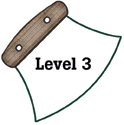
Alaska Science
Key Element A14b
A student who meets the content standard should understand that the living environment consists of individuals, populations, and communities (Interdependence).
 |
Alaska Science A student who meets the content standard should understand that the living environment consists of individuals, populations, and communities (Interdependence). |
|
Performance Standard Level 3, Ages 11–14
|
|
|
|
Sample Assessment Ideas
|
|
|
Expanded Sample Assessment Idea
|
|
Procedure Students will:
Reflection and Revision
|
Levels of Performance |
||
|
Stage 4 |
Student work is complete, and shows evidence of logical reasoning. Student performs a careful, well-documented count of individuals using standard techniques, and correctly extrapolates to the entire area under consideration. Student describes an extrapolation method to cover across a greater region and discusses methods to improve the accuracy of the data. | ||
|
Stage 3
|
Student work shows evidence of logical reasoning but may contain minor errors or omissions. Student performs a careful count of individuals, using standard techniques, and correctly extrapolates to the entire area under consideration. | ||
|
Stage 2
|
Student work may be incomplete, or contain errors of science fact and reasoning. Student performs a count of individuals and may extrapolate to a larger area. | ||
|
Stage 1
|
Student work may perform a cursory count of individuals but work is largely incomplete, may contain major misconceptions, and show little evidence of understanding. | ||
Standards Cross-References
|
||
|
National Science Education Standards A population consists of all individuals of a species that occur together at a given place and time. All populations living together and the physical factors with which they interact compose an ecosystem. (Page 157) Populations of organisms can be categorized by the function they serve in an ecosystem. Plants and some microorganisms are producers-they make their own food. All animals, including humans, are consumers, which obtain food by eating other organisms. Decomposers, primarily bacteria and fungi, are consumers that use waste materials and dead organisms for food. Food webs identify the relationships among producers, consumers, and decomposers in an ecosystem. (Page 157) |
Benchmarks All organisms, including the human species, are part of and depend on two main interconnected global food webs. One includes microscopic ocean plants, the animals that feed on them, and finally the animals that feed on those animals. The other web includes land plants, the animals that feed on them, and so forth. The cycles continue indefinitely because organisms decompose after death to return food material to the environment. (Page 104) Two types of organisms may interact with one another in several ways: They may be in a producer/consumer, predator/prey, or parasite/host relationship. Or one organism may scavenge or decompose another. Relationships may be competitive or mutually beneficial. Some species have become so adapted to each other that neither could survive without the other. (Page 117) |
|
Table of Contents | Return to Alaska Native Knowledge Network